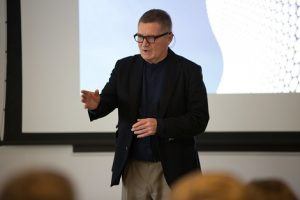December 20, 2017—Students from Harvard T.H. Chan School of Public Health and across the University came together at the Harvard iLab over the fall semester for an innovative new course—Design of Social Innovation. While some may have thought of “design” as the process of creating a building or smartphone, by the end of the course, they realized that they could utilize design to tackle large, ambiguous problems in public health.

Led by Patrick Whitney, visiting professor at Harvard Chan School, the course gave students a hands-on introduction to design methods such as modeling, reframing, and prototyping. Whitney, one of the foremost experts on the discipline of design as an approach to solving complex human problems, taught students new ways to approach public health challenges—as a supplement to standard science-based approaches—when information is incomplete and fast-changing.
As a case study, students were tasked to look at the World Health Organization (WHO) and the way it addresses pandemics, and then design solutions to help it more effectively manage disease outbreaks. To keep their thinking fresh, students were forbidden from researching how WHO already works. They looked at different models of change, made conjectures, and then researched whether their ideas could work.
Whitney said during the students’ final presentations on December 8, 2017, “This course is not about what is, but what might be.”
Gathering info from the ground
During the course, students worked in groups to design and prototype their projects. They received feedback from experts along the way, and had the opportunity to step back and rethink their approaches from a new angle. By the end of the course, they all reached the conclusion that the best way to help WHO address disease outbreaks is to not only improve the organization’s ability to disseminate information, but in parallel, to create a direct line with medical and aid workers on the ground to collect information and data in the world’s most vulnerable communities.
Each student group focused its work on a different country. Public health students Kevin Hall, MPH ’18, and Chrissy Kreider, MPH ’18, framed their project—an app called the WHO Action Health Platform—around the hypothetical experience of a specific doctor at a clinic in rural Colombia. If he began to see patients exhibiting unusual symptoms, he could search the platform’s database for more information. His and other providers’ queries would be aggregated by the system, alerting the WHO to a potential hotspot. If the doctor believed that an outbreak was underway, he could file a report within the platform to request help from local WHO experts.
Projects from other groups included an interface to connect non-profit organizations with WHO, sensors placed in bodies of water for capturing and transmitting water quality data, and systems for aggregating data from social media that might indicate an outbreak.
Ashish Jha, senior associate dean of research translation and global strategy, and K.T. Li Professor of Global Health, was a guest lecturer for the course. In remarks during the final presentations, Jha said that he was surprised and impressed by the direction the students took with their projects. Proposals for fixing WHO usually focus on how it can better disseminate knowledge to the field, he said. The students in this course upended that model.
“The class’s work has been extraordinary,” Jha said. “You have made more progress on rethinking, and indeed fresh thinking about WHO than I’ve seen for years,” he added.
Hall and Kreider both said that they were leaving the course with ideas for how to apply design concepts to their work. Hall, who had previously developed a cancer screening program for smokers, said that the new ways of thinking he had gleaned from the course will change the way he approaches future interventions in a variety of ways, from interactions with providers and clients, to goal setting.
Kreider, who is taking a year away from medical school to earn her MPH degree, hopes to take additional design courses and apply what she learns to improving healthcare delivery.
Photos: Sarah Sholes
